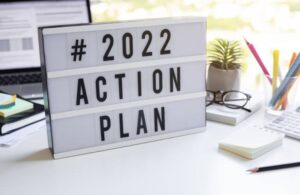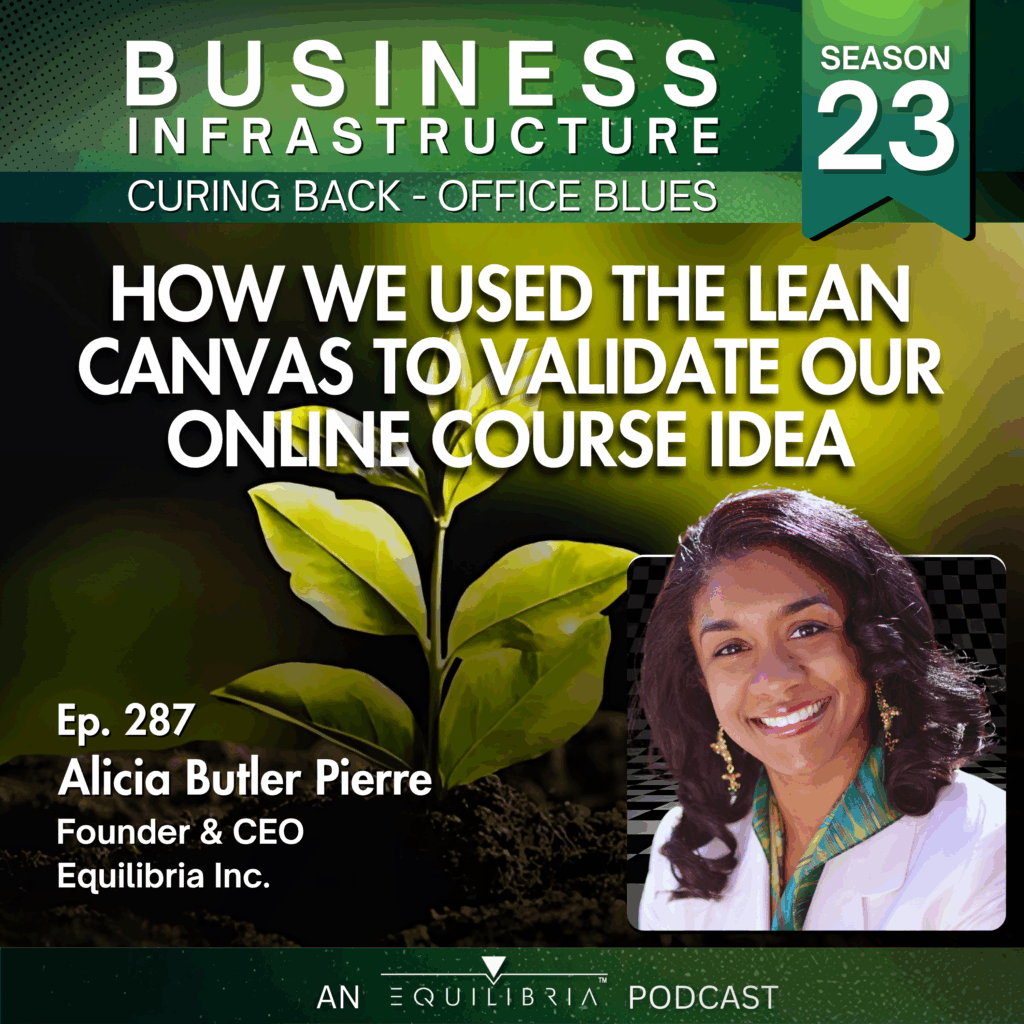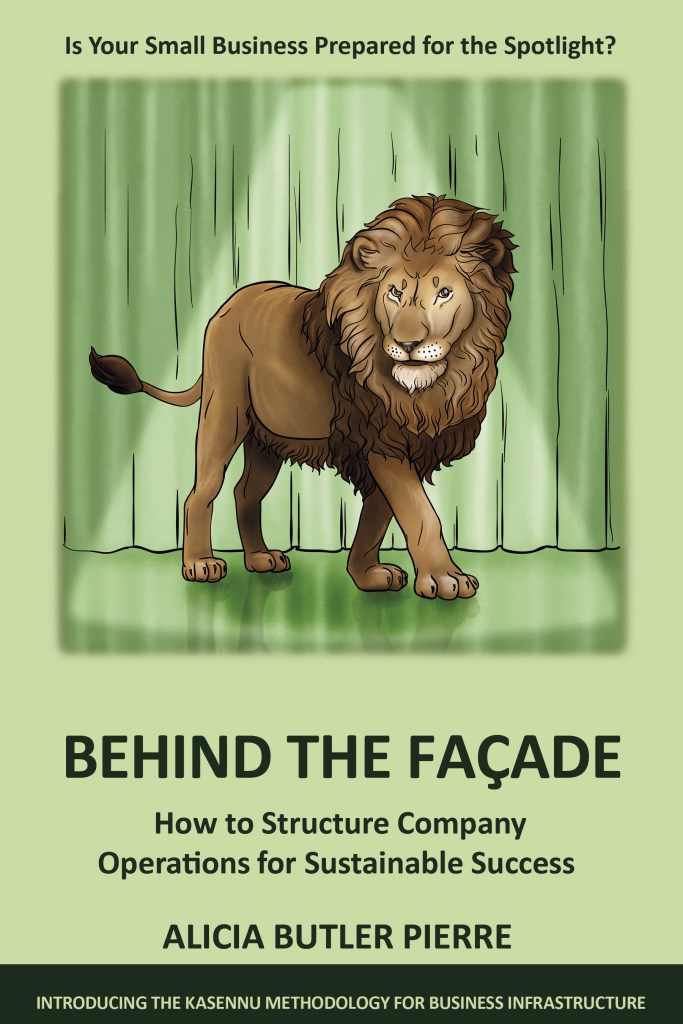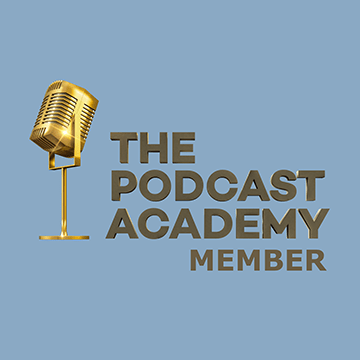Transcript
This is the Business Infrastructure Podcast – the show where we share operational tips, tactics, and strategies to help you cure any back-office blues you might be experiencing.
In the last episode, you heard our first lesson in preparing for your company’s growth strategy. It involved a tool called the Lean Canvas. Now you get a sneak peek at how we used the Lean Canvas to test some ideas we had for growth. You’ll get a firsthand account of what we did, the results, and where we went wrong.
This is Ep. 287: How We Used the Lean Canvas to Validate Our Online Course Idea
Hi there. I’m Alicia Butler Pierre, Founder and CEO of Equilibria, which is the underwriter of the business infrastructure podcast. We’re doing something very different, as we usually do on this season. Season 23 is focused on growth strategies, and I’ll share with
you why this is personally so near and dear to my heart. At my company at Equilibria, we are growing really fast and things are a bit chaotic.

So we’re also implementing our own business infrastructure to make sure that we scale successfully to the next level. But in coming up with the ideas for how we could best scale, we came to a realization that the company really needed to shift from a consulting business model into more of a teaching and training business model. Consulting will still be there, but our emphasis will now really be on the training and teaching component. It’s a lot of fun. Plus, it’s going to allow us to be able to scale in a way that the business can replicate itself over and over.
We can train other people to come and produce those training sessions. So, here’s what happened…and I want to take you on this journey with me. It started, I would say, really, two years ago when I started thinking about, gosh, I really enjoy training. I do some Lean Six Sigma training currently at Purdue University, and it really brings me a lot of joy to be able to see the proverbial light bulb go off in different people’s heads as you are explaining different concepts to them.
So I wanted to, I started toying around with this idea of shifting from consulting to training, but truthfully, it was just that – it was an idea. And it wasn’t until I met my good friend Martina Goss. She is outside of Dublin, and she specializes in creating something
called the Lean Canvas. So not only is it an actual tool or a diagram, but it’s really the methodology that goes behind the filling out of that diagram.

That’s what makes it so powerful. And she’s an expert in that. That is what she specializes in. It honestly helps you vet and then validate your ideas. So again, I had this idea. Wasn’t sure if it was marketable, certainly did not know for sure if it was going to
be the ticket to our company actually being able to achieve true scale. But it wasn’t until we started working with Martina. And I would say this went on for about 90 days starting two years ago. It is 2024, April of 2024, as I record this. But she helped me figure that out and that’s where it all started.
We have a gazillion ideas about how we can grow our businesses, but which of those ideas can really make the cut? So, what you’re about to see is me taking you on this journey. At this point, you’ve probably already heard from Martina. If you haven’t, make sure you go down in the description box below and click the link so that you can watch a video with her explaining first what the Lean Canvas is and then come back here.
Pick up where you left off with this video because I want to take you on this journey with me so that you can hopefully not only learn something new, but also figure out if these are some tools and tips and tactics and even maybe strategies that you can apply in your own business’ growth strategy.
So, with that in mind, I will now go ahead and open up my company’s Lean Canvas, the very one that Martina Goss helped me complete, so that you can follow along and see how we were able to really vet this training idea and hone it and really try to understand what in fact we could pursue as part of a strategy to not just grow, but also scale.
So what I have up here on the screen, and I do understand that for those of you who are listening to the podcast, only you don’t have the benefit of seeing the actual Lean Canvas. So I do encourage you to head on over to businessinfrastructure.tv, where you will actually be able to see it.
And for those of you who may have some type of visual impairment, I will do my best to explain what we are looking at visually on the screen. Okay, here goes. Before I start talking about the Lean Canvas, you do actually see a blank Lean Canvas here on your screen. Martina Goss and I started working together in the fall of 2022. So as of this recording, it was literally two years ago, which is so hard to believe.

And it started because I had an idea to transition Equilibria from a consulting only company to more of a training business model. And I saw an online course as a way of facilitating that training, but also as a way of us being to really scale our operations. We talk about scale all the time here on this show, as well as with our consulting clients. And so we needed to kind of take a dose of our own medicine. And this was a way I saw for us to be able to do that.
Martina and I worked together for six weeks, like the last quarter of 2022 from about October to the beginning of December, we worked together, and she was very patient with me. One of the first things that she did was she sent a blank Lean Canvas to me and asked me to fill it out. And if you’ll recall, if you go back and listen to the interview or the episode where she actually explains how to use the Lean Canvas, or how she facilitates the use of the Lean Canvas, that is exactly what she mentioned, and that is what happened with me. So what you see here on the screen is a Lean Canvas.
This is a newer version compared to the one that Martina and I used when we were working together. But again, the concept is the exact same. It asks twelve different questions. It is a onepage document. And when I received this template, it was actually in the form of an Excel spreadsheet.
So that allowed us to really add more rows and just to be able to put as much information as we possibly can, getting all of that information out of our heads and onto this spreadsheet. But again, there are these main sections. Problem, Solution, Unique Value Proposition, Unfair Advantage, Customer Segments, High Level Concept, Channels, Cost Structure and Revenue Streams. Now, you will notice there’s a total of twelve sections or questions, but there’s really nine main areas of the canvas with a total of twelve questions that are being asked.
What I’m going to show next is the first canvas that I actually completed for my company. One of the first things that may really stand out to you is if you look at the very bottom of the screen, you will notice that the very first tab is called Master Copy. And then there’s a series of other tabs.
Let me explain what happened when I first filled out this canvas. Again, just a quick brain dump, no more than 20 to 30 minutes. I shared this with Martina and by the time we met for our subsequent sessions, she said, “Okay, Alicia, you have multiple ideas,” that were kind of crammed into one page, which is, which is the point. And then she helped me figure out how to separate those ideas into different tabs on the same spreadsheet. So that’s why, for example, at the bottom of this, you actually see Master Copy, Academia, CEOs, Non-Regulated Government, so forth and so on.
That was literally taking the information from that original brain dump and just splitting out those ideas, those separate ideas onto separate tabs, literally creating a Lean Canvas for each. I’ll focus on this one in particular. The title, which is at the very top of this canvas, is called Online Course – Business Infrastructure. Now, here’s what’s funny – although we went through the Lean Canvas for this particular idea to create an online course for business infrastructure, we had, in fact, already created the course and it was not a success at all, to be very honest with you.

And that was mistake number one, was that we just, we did exactly what we talked about in the interview with Martina. We had an idea, we thought it was great, and so we just kind of went for it. We invested all of these resources, editors, scripting, cameras, lighting, and no one, well, I should say not too many people actually purchased the course. And we spent a ton of money on YouTube ads, SEO strategic campaigns, and all kinds of other online promotions, and it flopped. And we were trying to basically course correct, no pun, intended by working with Martina, working backwards and saying, Okay, why didn’t this work?
Is this really an idea that we should pursue in the first place? I won’t go through everything because I don’t want to make this video or this podcast episode terribly long. But here’s what I’ll point out. We first focused on the Problems section, where we had to list one to three problems, top problems.
And this is from your customer or your prospective customer’s perspective. We’ll go all the way over here to the far right of the screen where you see customer segments, and it’s the sub. The action to take here is to list all of your target users. So this was who are the people that would be interested in this course on business infrastructure?
And then I’ll scroll down just a little bit. I’ll go back over here to the far bottom left of the screen. There is a section called Existing Alternatives. How are the problems that you identified in the problem section, how are those problems solved today for the customers that you’ve identified?
And then finally, we’ll go all the way over to the far right at the bottom again, the Early Adopters section. This is where you are to list the characteristics of your ideal customers. Who are those people ideally? We fill that information out and I’ll just, I’ll just read a few things to share with you.
One of the first problems we mentioned is the fact that entrepreneurs cannot keep up with the demand for their products and services. There’s no order or organization to their operations. Their processes aren’t documented. They have high employee turnover. So these are things that we have noticed with our consulting clients for many, many years.
And so the solution is to provide them with this online course in business infrastructure. I’ll go back down to the Existing Alternatives. How are these problems solved today? Well, with the problems that I just stated, one of the things that our clients typically do now, our consulting clients, is they can find other business coaches or consultants to work with. They can seek assistance from many U.S. government agencies like the SBA or the SBDC, or they can just try to fix it themselves.

Or they can pawn off the work to their office manager, general manager, or COO, if they are lucky to have such people around on their teams. As far as Customer Segments, there’s academia, there’s online learners, there’s CEOs of fast-growing manufacturing and service based micro enterprises.
So again, these are just some of the different types of people that would potentially be interested in taking this online course in business infrastructure. And then for Early Adopters, we have, these are potentially people who have failed an audit or they preemptively are trying to prepare for an audit. So again, there’s some activity around an audit, and that happens for many, many people who operate in organizations or industries that are heavily regulated.
And then this is another favorite of mine. I shouldn’t say it’s a favorite, it’s a good problem to have, but an entrepreneur who has had a viral moment and they find that their website crashes. So again, it’s just a, you know, these are the types of people who may be early adopters because they understand why business infrastructure is important, why it’s valuable, why it’s needed, why it matters, and they would be so inclined as to invest in an online course instead of investing potentially thousands of dollars working with an actual consultant. So this was version one of our Lean Canvas. Here’s what happened.
We started to have more and more sessions with Martina, and the more we talked, the more it became clear why the online course for the business infrastructure idea didn’t do well. And it’s really because we should have led with another type of course and then potentially upsell the business infrastructure course. And I’m hoping that makes sense. So one of the other ideas that we had for an online course had to do with process mapping. So I’ll go ahead and open that Lean Canvas as well.
And before I do, actually, let me go back here because I want to share with you all what the Leaner Canvas looks like, because there’s a reason that Martina is very strategic when she’s working with you. And as she worked with us, she had us fill out those outer four boxes of the Lean Canvas first, and that’s known as the Leaner Canvas. So what I’m showing on the screen right now is literally those main, those four sections: problem, customer segments, existing alternatives and early adopters. She had us work on that first. So you kind of fill out the edges and then you go and start to fill in or populate data, the middle sections of the Lean Canvas as well.
You can make sure that you download the Lean Canvas and the Leaner Canvas templates from the show notes at businessinfrastructure.tv. So let’s go back now to what I have here is this one is dated December 7, 2022. So going from October now into December, you can see that there is, we’re honing in on this idea of an online course, but changing direction a little bit.
We now have a new tab at the bottom called Lean Professionals. So this was the specific customer segment that we were looking at and we developed a Lean Canvas around what type of course would these people be looking for? And it was an idea that I had to create a course around process mapping. Well, I actually teach a Lean Six Sigma course for process improvement and quality management at a university now, and I knew that there was a gap. I had a proposed idea for how to fill that gap, but I still wasn’t sure.

So it was perfect timing to work with Martina in developing a Lean Canvas or Leaner Canvas to try to understand if this was an idea that I should continue pursuing. And without going through all of the steps here, you can see here that I intentionally highlighted the areas of the Leaner Canvas. It gets into a lot of detail.
We don’t want to reveal too many proprietary things here so I did intentionally scrub this Lean Canvas a bit. But the point is for you all to understand the evolution of how we started with one idea and it kind of started to grow legs, if you will. Martina was patient enough with us to actually explore a Lean Canvas for every single one of those ideas that sprouted. After we completed the Leaner Canvas, we then went in and filled in the middle section.
So the solution, what is our unique value proposition? What is our unfair advantage? What are some of the different channels or paths to our customers? What are some key metrics that will let us know if we are doing well? What is the high-level concept?
In other words, what’s a clever analogy for this process mapping online course? And then finally, what is the cost structure? What are the fixed and variable costs that are associated with standing up a new course, promoting that course and delivering that course? And then finally, what are the different ways that we can make money from this course? Once we had a completed Lean Canvas, that’s when our work with Martina started to wrap up and she left us with the customer discovery piece.
And that’s what I want to share with you all about a little bit more. What we started doing. Because I was working at a university and they have a relationship with another organization that provides lead generation services for them. I had to be very careful because I could not directly survey students. So, whenever I had one on one conversations with those students, that’s when I would ask them, If the university were to offer a course in process mapping, would you take it?
Would it be valuable to you? Why? And honestly, I have to tell you, I’m so glad that Martina encouraged me to do this customer discovery and to find a clever and creative way for getting that information, short of not being able to conduct a survey, because it really gave me the validation that I needed. Now I just had to figure out what the students would actually pay for it. And this is what led Monique and Erika from our team here at Equilibria to conduct research on similar courses.
So at this point, we had a completed Lean Canvas, we had a validated idea for an online course – one that was desirable, viable, and feasible,. We knew what to charge, but we got stuck with the next steps. And not to mention, life honestly got in the way, too. And I detail much of this in a three-part series featured in LinkedIn, and we’ll have links to those articles in this episode’s show notes as well.
Okay, now that you’ve seen how we use the Lean Canvas here at Equilibria to really hone in on what does this new training model look like for the business, it’s time now to actually develop a strategy around that. So, we have the idea of all of the ideas that were presented. Martina really helped us figure out how to again hone in on that idea that would actually help us scale. And now it’s time to start talking about how do we formalize that idea in the form of a strategy, a strategy that can actually be implemented. Because what good does it do is to come up with a strategy and not be able to implement it?
Thank you for listening! Visit BusinessInfrastructure.TV to download your free copy of a Lean Canvas template. Again that’s BusinessInfrastructure.TV.
If you enjoyed being a part of this journey, then please subscribe to the show, give us a five-star rating and…we’d love it if you left us a review.

Good luck in completing your Lean or Leaner Canvas. Reach out to Martina Goss if you need an objective analysis. Her contact information is available in this episode’s show notes. Now it’s time to take our validated idea and develop a strategic growth plan around it. You’ll learn how to do that in the next episode.
Be sure to come back to the place wherever you’re listening so you don’t miss it! Until then, remember to stay focused and be encouraged. This entrepreneurial journey is a marathon and not a sprint.
This podcast episode was written and produced by me, Alicia Butler Pierre. Audio editing and sound design by Sabor! Music Enterprises. Video editing by Gladiola Films. A special thank you to the team here at Equilibria, Inc., and to Grant Revilla for creating the show notes.
This is the Business Infrastructure – Curing Back-Office Blues podcast.
















